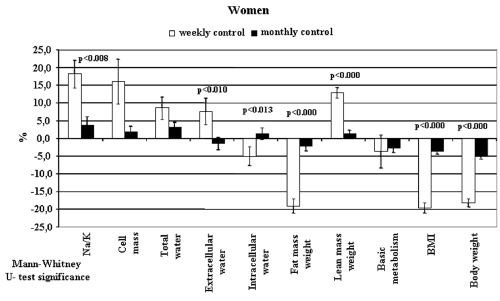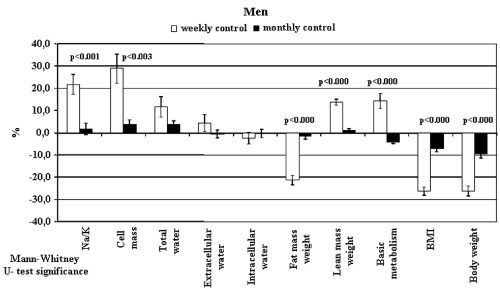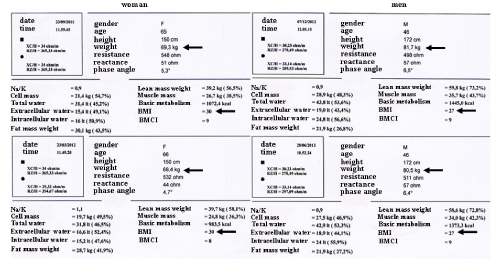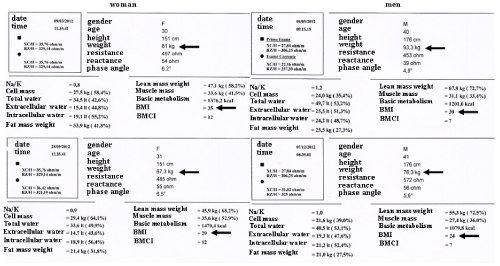Research Article Open Access
Diet Therapy of Obesity: Observations on the Usefulness of Weekly Supervision in the Improvement of Weight Loss
| Teresa Esposito1,2*, Anna Napoleone1, Salvetore Allocca1, Bruno Varriale2 and Marcellino Monda1,2 | |
| 1Department of Experimental Medicine, Second University of Naples, Italy | |
| 2Department of Medicine, Second University of Naples, Italy | |
| Corresponding Author : | Teresa Esposito Department of Experimental Medicine Second University of Naples, Naples, 80138, Italy Tel: +390815667621 E-mail: teresa.esposito@unina2.it |
| Received June 27, 2014; Accepted August 21, 2014; Published August 25, 2014 | |
| Citation: Esposito T, Napoleone A, Allocca S, Varriale B, Monda M (2014) Diet Therapy of Obesity: Observations on the Usefulness of Weekly Supervision in the Improvement of Weight Loss. J Obes Weight Loss Ther 4:225. doi:10.4172/2165-7904.1000225 | |
| Copyright: © 2014 Esposito T, et al. This is an open-access article distributed under the terms of the Creative Commons Attribution License, which permits unrestricted use, distribution, and reproduction in any medium, provided the original author and source are credited. | |
Visit for more related articles at Journal of Obesity & Weight Loss Therapy
Abstract
Background and aims: Obesity, a condition born in the rich countries of the West, is rising in the rest of the world. The developing countries are adopting the eating habits and the lifestyle of the rich countries. The purpose of this study was to evaluate, on obese subjects, the effect of a diet therapy with weekly control with respect to the effect of the same monthly check, as by traditional protocol. Methods: Forty patients with first degree of obesity were treated with hypocaloric diet therapy for 6 months with weekly checks, while other 40 patients were treated with the same diet therapy but with monthly control. Examination has allowed to assess nutritional status, to estimate body composition and provide guidance for the calculation of individual nutrient needs and to evaluate the effectiveness of nutritional therapy. The analysis of the parameters was carried out mainly through the survey of the body data changes as per protocol. Moreover, taking advantage of the BIA (Bio-impedance) we were able to follow the trend of the effectiveness of the diet regimen in both groups. Results: The slimming of the weekly control group resulted 63% greater than the monthly control group. In both men and women the weekly check produces significant differences by increasing the effects of diet therapy treatment. Reaching statistical significance not only for the decrease in body weight but also for the majority of BIA parameters considered in our analysis. Conclusion: The results, thus obtained, indicate that the weekly monitoring can improve the “compliance” of the patient in diet therapy.
| Keywords |
| Diet; Obesity; Weight loss; Bio-impedance; Weekly control |
| Introduction |
| Obesity is considered an endemic disease, as widespread in a population geographically limited. Specifically, obesity is typical prerogative, even if not exclusively, in Western countries, where about one third of the population is overweight. The United States had so far the country “negative guidance”, with approximately 69% of the population overweight or obese, followed by Australia and Great Britain. In Europe this condition is nearly 50%, but the problem continues to worsen rapidly. The WHO has defined this condition a pandemic [1,2]. |
| The high prevalence of very high Waist circumference in our study population, especially among women, may be explained by their seven-fold greater risk of developing central obesity. A study by Pischon et al. [3] showed that each 5 cm above WC reference values increases cardiovascular risk by 13% in women and 17% in men. However, Sánchez et al. [4] found that in general women have more subcutaneous fat in the abdominal region, while men tend to have more visceral adipose tissue, which may explain their higher risk for chronic diseases since visceral fat has greater pro-inflammatory characteristics than subcutaneous fat [5]. According to ISTAT data, in 1999 the Italian overweight were approximately 33.6% of the population, while the obese were “only” 9.1%. Since then, the obesity epidemic has not mentioned slowdowns, so that has now reached the threshold of 10% (9.8%). Also a growing number of Italian overweight increased from 33.6% in 1999 to the current 34.2%. Obesity is a disease condition characterized by an excess of fat mass compared to lean body mass, according to the limits considered normal for age, sex and height. In general when it comes to obesity: the body weight exceeds the ideal weight of a quantity equal to at least 20%; or when the body mass index (BMI) is above 30 kg/m [2,6]. Furthermore, studies using doubly labeled water indicated that individuals with higher than recommended body mass index (BMI) >25 have a high absolute total energy expenditure as compared to individuals with lower BMI [7-9]. Although the prevalence of extreme obesity, as defined by BMI ≥ 40, is about 5% in population of the industrialized world, representing an important increase over the last 40 years, few studies have investigated the modification of the obesity status following the subjects with close regular control and the usual protocol concerns a monthly check of effectiveness of diet therapy [10]. The aim of this work was to measure the weight loss in severely obese adults and their respective bodily changes after every week for six months of monitoring, compared with patients with monthly monitoring since there are no works that have investigated such correlation in terms of loss of body weight, and bio-impedance examination compared with a loss of the same parameters in monthly check patients with a state of obesity BMI >30. |
| Materials and Methods |
| All treatments follow the guideline of our Comitato Etico dell’Azienda Ospedaliera Universitaria of the Second University of Naples. The study was performed in accordance with the ethical standards stated in the 1964 Declaration of Helsinki and approved by the local clinical research ethics committee; informed consent was obtained from all subjects before examination. |
| Male and female subjects (n=80) were enrolled between the subjects of the Department of Clinical Dietetics at the Second University of the Studies Naples, Italy, with a height ranging from 1.60 to 1.75 m, so that the population of all subjects was homogeneous in terms of height. Subjects aged between 30-40 years avoiding women in menopause status. The patients do not have diabetes, hypertension, metabolic syndrome and any thyroid illness. All patients follow a low-calorie diet therapy. The low-calorie diet of each patient was made keeping in mind their bioelectrical impedance (BIA), their energy expenditure related to daily physical activity level (PAL) or Integrated Energy efficiency index (IEI), as reported by Human energy requirements-Report of a joint FAO/WHO/UNU expert Consultation, 2001.The diet was divided into 5 meals, and according to the diagram of the Food Pyramid (extensive use of fresh vegetables , foods containing fiber), satisfying a calculation that would lead to a reduced calorie diet divided into about 50% carbohydrates, about 20% protein, about 30% lipids. Lipids are in turn subdivided according to the habits of the Mediterranean diet: 1\4 lipids containing saturated fatty acids, approximately 1\2 of lipids containing monounsaturated fatty acids, 1\4 lipids containing polyunsaturated fatty acids (with a ratio between omega-3/omega6 of 5:1). |
| Forty patients with First Instance obesity were treated with lowcalorie diet therapy for 6 months with weekly checks, while other 40 patients were treated with same diet therapy but with the monthly check. For measurement of weight and height, the two outpatient clinics followed the methods recommended by anthropometric standardization reference manual Lohman et al. [11] using platform scales (capacity 150 kg in 100 g divisions) with stadiometer (in 1-mm divisions). Weight and height were then used to calculate BMI, using the classification recommended by the WHO. WC was measured with a non-stretch tape measure according to the standards and cut-offs recommended by the WHO. The subjects were divided into two groups: the first group with a BMI ranging from 30 to 34.9 kg/m2, and the second group with BMI >40 kg/m2. Each group was divided into two subgroups related to sex (n=20 for each subgroup) The subjects used in this study were healthy (do not have diabetes, hypertension, metabolic syndrome and any thyroid illness) and stable in weight for a period of three months preceding the study. Each subject had a normal physical examination. The weight was measured without shoes or clothing to the nearest 0.1 kg. The participants were fasted overnight for at least 12 h. |
| The measurements BIA (bioelectrical impedance) was conducted between 8:00 to 10:00 am and before the beginning of the measurements the subjects had rested quietly for 30 min. Body composition was calculated by bioelectric impedance using an analyzer (Akern BIA- 101/S, Italy). For reasons of brevity, only the percentage of FFM (calculated as kg of FFM/kg of total body weight × 100) was reported in this article. The values are presented as means ± SE. Statistical analysis was performed using the analysis of variance. All texts for comparison between groups with and those without weekly control were performed using the non-parametric U test of Mann-Whitney test. |
| Taking advantage of the BIA (bio-impedance examination) suitable for the assessment and body composition analysis we were able to follow the trend of the weekly Total Body Water (%), Extracellular Water (%), Intracellular Water (%), Mass lean (%), Fat Mass (%), Basal metabolism (calories). |
| Results |
| The weight loss of the group with weekly control was 63% higher (p<0.000) with respect to monthly monitoring regardless of age or sex of the patients (Figures 1 and 2). |
| In both women and men (Figures 3 and 4) the weekly check produces significant differences by increasing the effects of diet therapy treatment. Reaching statistical significance not only for the decrease in body weight but also for the majority of BIA parameters considered in our analysis. Hence, the exchangeable Na/K increases significantly (p<0.001 in man and p<0.008 women) in weekly control with respect to the monthly ones. In both sexes the fat mass weight (p<0.000 in women and man), BMI (p<0.000 in women and man) and body weight (p<0.000 in women and man) significantly decrease in weekly control groups with respect to the monthly checked groups. Also the lean mass weight significantly increases in both sexes (p<0.000) in weekly controlled groups. As far as it concerns the extracellular and intracellular water, our results show significative differences only in women checked weekly with respect to the monthly control (p<0.010 and p<0.013 respectively). |
| An exception is the basal metabolic rate which increases in men with weekly check (p<0.000) while in women even decreases. |
| Discussion |
| Despite the varying definitions it is clear that the incidence of the obesity is increasing among men and women of all ages and ethnicities [12] depending on the wellness of population. The prevalence of obesity is also increasing worldwide, with the condition predicted to affect more than one billion people by the year 2020 [13]. The increasing global prevalence of obesity in children and adults, and its medical and socio-economic consequences represent a major public health concern. |
| Complex gene-environment interactions are certainly contributing to the current diabesity epidemic. Nutrition and physical activity are key environmental factors, which potentially interact with genetic predisposition, to promote the progression and pathogenesis of these combined environmental and polygenic, diet-related diseases. More than half of adults in Europe and the US are overweight or obese [14]. There is no doubt that a genetic component can also impact on the risk of insulin resistance, the sensitivity to which may be further amplified by poor diet. At a public health level, more attention must be given to modification of lifestyles of the general public to reduce risk of obesity. At a clinical level, individual patients with increased metabolic risk need to be identified so that their multiple risk factors can be reduced. Implementation of healthy lifestyle changes in nutritional behavior and exercise or pharmacotherapy, may be important in reducing disease development. |
| From the nutritional/dietary advice perspective, this paper has explored the usefulness of close follow in subjects with first type obesity with respect to the usual monthly or longer monitoring. In our study, the controls were carried out for a period of six months. With the same low-calorie diet, diet therapy have placed better to the subjects who were weekly monitored than those who were monthly monitored. From our data emerges as important result, that obese patients subjected to continuous monitoring and close in time have the ability to reduce body parameters more intensely and in a shorter time. It seems obvious that these results are not attributable only to the type of low-calorie diet suggested because the same type of diet is also recommended to those who are monthly checked. This suggests that most likely the psychological component in patients receiving weekly check will encourage them to keep the feeding behavior suggested by the medical specialist in dietetics. Thus, a part the genetic component, the environmental factors and social conditions, there is also a psychological component in determining the state of obesity. This suggests that to achieve the best results from a diet therapy is necessary an ongoing relationship of trust with the medical specialist in dietetics, to create an empathy between them in order to get better results. Lastly we suggest a new approach to obese patients that provides a new protocol in which the steady-state controls by dietician and the patient’s body parameters should be performed weekly for faster, longer and more stable results. |
| Acknowledgement |
| TE, BV, and MM designed research; TE, AN, SA, conducted research; BV analyzed data; TE, BV, and MM wrote the paper. TE had primary responsibility for final content. All authors read and approved the final manuscript. |
References
- Thompson D, Wolf AM (2001) The medical-care cost burden of obesity.Obes Rev 2: 189-197.
- Diverse Populations Collaborative Group (2005) Weight-height relationships and body mass index: some observations from the Diverse Populations Collaboration.Am J PhysAnthropol 128: 220-229.
- Pischon T, Boeing H, Hoffmann K, Bergmann M, Schulze MB, et al. (2008) General and abdominal adiposity and risk of death in Europe.N Engl J Med 359: 2105-2120.
- Piernas Sánchez CM, Morales Falo EM, Zamora Navarro S, GarauletAza M (2010) Study and classification of the abdominal adiposity throughout the application of the two-dimensional predictive equation Garaulet et al., in the clinical practice.NutrHosp 25: 270-274.
- Huffman DM, Barzilai N (2009) Role of visceral adipose tissue in aging.BiochimBiophysActa 1790: 1117-1123.
- MacKay NJ (2010) Scaling of human body mass with height: the body mass index revisited.J Biomech 43: 764-766.
- Black AE, Coward WA, Cole TJ, Prentice AM (1996) Human energy expenditure in affluent societies: an analysis of 574 doubly labeled water measurements. Eur J ClinNutr 50: 72-92.
- Schoeller DA (1999) Recent advances from application of doubly labeled water to measurement of human energy expenditure.J Nutr 129: 1765-1768.
- Monda M, Messina G, Mangoni C, De Luca B (2008) Resting energy expenditure and fat-free mass do not decline during aging in severely obese women.ClinNutr 27: 657-659.
- Strychar I (2006) Diet in the management of weight loss.CMAJ 174: 56-63.
- Lohman TG, Roche AF, Martorell R (1991) Anthropometric standardization reference manual. Champaign, Illinois: Human Kinetics Books.
- Ford ES, Li C, Zhao G (2010) Prevalence and correlates of metabolic syndrome based on a harmonious definition among adults in the US.J Diabetes 2: 180-193.
- Flier JS (2004) Obesity wars: molecular progress confronts an expanding epidemic.Cell 116: 337-350.
- Eckel RH, Grundy SM, Zimmet PZ (2005) The metabolic syndrome.Lancet 365: 1415-1428.
Figures at a glance
 |
 |
 |
 |
| Figure 1 | Figure 2 | Figure 3 | Figure 4 |
Relevant Topics
- Android Obesity
- Anti Obesity Medication
- Bariatric Surgery
- Best Ways to Lose Weight
- Body Mass Index (BMI)
- Child Obesity Statistics
- Comorbidities of Obesity
- Diabetes and Obesity
- Diabetic Diet
- Diet
- Etiology of Obesity
- Exogenous Obesity
- Fat Burning Foods
- Gastric By-pass Surgery
- Genetics of Obesity
- Global Obesity Statistics
- Gynoid Obesity
- Junk Food and Childhood Obesity
- Obesity
- Obesity and Cancer
- Obesity and Nutrition
- Obesity and Sleep Apnea
- Obesity Complications
- Obesity in Pregnancy
- Obesity in United States
- Visceral Obesity
- Weight Loss
- Weight Loss Clinics
- Weight Loss Supplements
- Weight Management Programs
Recommended Journals
Article Tools
Article Usage
- Total views: 15397
- [From(publication date):
September-2014 - Apr 04, 2025] - Breakdown by view type
- HTML page views : 10767
- PDF downloads : 4630
